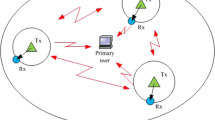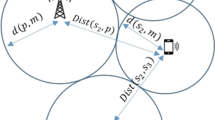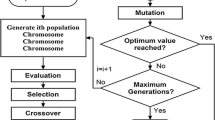Abstract
Proportional fair resource allocation plays a critical role to balance the spectrum efficiency and fairness for cognitive orthogonal frequency division multiplexing (OFDM) network. However, due to the lack of cooperation between cognitive radio (CR) network and primary network, channel state information between CR base station (CRBS) and primary user (PU) could not be estimated precisely. Therefore, the interference of CRBS–PU couldn’t be computed precisely and chance-constrained programming is adopted to formulate the resource allocation problem. In this work, we study the proportional fair resource allocation problem based on chance-constrained programming for cognitive OFDM network. The objective function maximizes the spectral efficiency of cognitive OFDM network over subcarrier and power allocation. The constraint conditions include the interference constraint of PU with the target probability requirement and the proportional fair rate requirement of CR users. In order to solve the above optimization problem, two steps are taken to develop hybrid immune optimization algorithm (HIOA). In the first step, the probabilistic interference constraint condition is transformed as an uncertain function which is computed by a generalized regression neural network (GRNN). In the second step, we combine immune optimization algorithm and GRNN to develop HIOA. Simulation results demonstrate that HIOA yields higher spectral efficiency while the probabilistic interference constraint condition and the proportional fair rate constraint condition could be satisfied very well.







Similar content being viewed by others
References
Alberto, R., Quek, T., Shin, H., et al. (2011). Cognitive network interference. IEEE Journal on Selected Areas in Communications, 29(2), 480–493.
Giorgio, Q., Hemanth, M., & Tamma, B., et al. (2010). Cognitive network interference through Bayesian network analysis. In IEEE international conference on GLOBECOM (pp. 1–6). Piscataway: IEEE.
Fu, L. Y., Qian, L., Tian, X. H., et al. (2012). Percolation degree of secondary users in cognitive networks. IEEE Journal on Selected Areas in Communications, 30(10), 1994–2005.
Michele, M., & Moretti, M. (2008). Robust frequency synchronization for OFDM-based cognitive radio systems. IEEE Transactions on Wireless Communications, 7(2), 5346–5355.
Sun, S., Ju, Y. H., & Yamao, Y. (2013). Overlay cognitive radio OFDM system for 4G cellular networks. IEEE Wireless Communications, 20(2), 68–73.
Mauricio, I., Anne, W., Tara, A. Y., & Adre, L. B. (2013). Resource allocation for real time services in LTE networks: Resource allocation using cooperative game theory and virtual token mechanism. Wireless Personal Communications, 72, 1415–1435.
Ioannis, G. F., & Stavros, A. K. (2013). Queue-aware resource allocation for multi-cell OFDMA systems with QoS provisioning. Wireless Personal Communications, 71, 3033–3044.
Zhang, Y. H., & Leung, C. (2009). Resource allocation for non-real-time services in OFDM-based cognitive radio systems. IEEE Communications Letters, 13(1), 16–18.
Zhang, Y. H., & Leung, C. (2009). Cross-layer resource allocation for mixed services in multiuser OFDM-based cognitive radio systems. IEEE Transactions on Vehicular Technology, 58(8), 4605–4619.
Zhang, Y. H., & Leung, C. (2009). Resource allocation in an OFDM-based cognitive radio system. IEEE Transaction on Communications, 57(7), 1928–1931.
Wang, S. W. (2010). Efficient resource allocation algorithm for cognitive OFDM systems. IEEE Communications Letters, 14(8), 725–727.
Zhang, Y. H., & Leung, C. (2011). A distributed algorithm for resource allocation in OFDM cognitive radio systems. IEEE Transactions on Vehicular Technology, 60(2), 546–554.
Chen, C. H., Wang, C. L., & Chen, C. T. (2011). A resource allocation scheme for cooperative multiuser OFDM-based cognitive radio systems. IEEE Transactions on Communications, 59(11), 3204–3215.
Shaat, M., & Bader, F. (2012). Asymptotically optimal resource allocation in OFDM-based cognitive networks with multiple relays. IEEE Transactions on Wireless Communications, 11(3), 892–897.
Ge, M. Y., & Wang, S. W. (2012). Fast optimal resource allocation is possible for multiuser OFDM-based cognitive radio networks with heterogeneous services. IEEE Transactions on Wireless Communications, 22(4), 1500–1509.
Wang, S. W., Ge, M. Y., & Zhao, W. T. (2013). Energy-efficient resource allocation for OFDM-based cognitive radio networks. IEEE Transactions on Communications, 61(8), 3181–3191.
Soltani, N. Y., Kim, S. J., & Giannakis, G. B. (2013). Chance-constrained optimization of OFDMA cognitive radio uplinks. IEEE Transactions on Wireless Communications, 12(3), 1098–3869.
Zhou, K. N., & Lok, T. M. (2012). Resource allocation for secondary users with chance constraints based on primary links control feedback information. EURASIP Journal on Wireless Communications and Networking, 1(138) 1–13.
Wang, S. W., Huang, F. J., Yuan, M. D., & Du, S. D. (2012). Resource allocation for multiuser cognitive OFDM networks with proportional rate constraint. International Journal of Communication Systems, 25(2), 254–269.
Wang, S. W., & Huang, F. J. (2013). Adaptive proportional fairness resource allocation for OFDM-based cognitive radio networks. Wireless Networks, 19(3), 273–284.
Tao, M. X., Liang, Y. C., & Zhang, F. (2008). Resource allocation for delay differentiated traffic in multiuser OFDM systems. IEEE Transactions on Wireless Communications, 7(6), 2190–2201.
Specht, D. F. (1991). A general regression neural network. IEEE Transactions on Neural Network, 2(6), 568–576.
Gen, M. S., Liu, B. D., & Ida, K. C. (1996). Evolution program for deterministic and stochastic optimizations. European Journal of Operation Research, 94(3), 618–625.
Song, Z. Y., Gao, X. Z., Huang, X. L., & Lin, H. S. (2006). A modified immune optimization algorithm. In Proceedings of the fifth international conference on machine learning and cybernetics (pp. 1–6). IEEE: Piscataway.
Xu, Y., Luo, F., & Lin, X. L. (2010). Hybrid destination registration elevator group control system with artificial immune optimization algorithm. In IEEE international conference on the 8th world congress on intelligent control and automation (pp. 5067–5071). IEEE: Piscataway.
Jin, Z. X., & Fan, H. J. (2013). An improved immune genetic algorithm for multi-peak function optimization. In IEEE international conference on the 5th international conference on intelligent human-machine systems and cybernetics (pp. 504–507). IEEE: Piscataway.
Cheng, H. T., & Zhuang, W. H. (2009). Novel packet-level resource allocation with effective QoS provision for wireless mesh networks. IEEE Transactions on Wireless Communications, 8(2), 694–700.
Hosseini, K., & Adve, R. (2010). Relay selection and max-min resource allocation for multi-source OFDM-based mesh networks. In IEEE international conference on ICC (pp. 1–6). IEEE: Piscataway.
Jiho, J., Kwang, B. L., & Lee, Y. H. (2002). Frequency-time domain transmit power adapation for OFDM systems in multiuser environment. Electronics Letters, 38(25), 1754–1756.
Acknowledgments
The authors gratefully acknowledge the financial support from The national natural science foundation of China (Nos. 61301108, 61371169), Jiangsu planned projects for postdoctoral research funds (No. 1301024C), the postdoctoral science foundation of China (No. 2013M541672), the key technology R&D program of Jiangsu (No. 201230225), the funding of Jiangsu innovation program for graduate education grant (No. CXLX13_169).
Author information
Authors and Affiliations
Corresponding author
Rights and permissions
About this article
Cite this article
Xu, L., Lv, Tm., Li, Qm. et al. Proportional Fair Resource Allocation Based on Chance-Constrained Programming for Cognitive OFDM Network. Wireless Pers Commun 79, 1591–1607 (2014). https://doi.org/10.1007/s11277-014-2028-0
Published:
Issue Date:
DOI: https://doi.org/10.1007/s11277-014-2028-0




